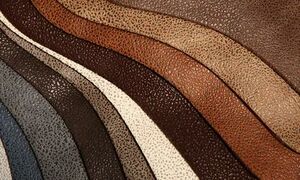- v50 information can now be added to pages in the main namespace. v0.47 information can still be found in the DF2014 namespace. See here for more details on the new versioning policy.
- Use this page to report any issues related to the migration.
DF2014:Leather
| This article is about an older version of DF. |
Leather is the tanned hide of an animal, and is a fairly versatile material. Leather can be used to make bags, quivers, backpacks, waterskins, clothing, shields, armor, and decorations, all at a leather works. Leather crafts are made at a craftsdwarf's workshop. Although most of these items can be made from other materials, it is the only sensible option for making quivers and backpacks (the only alternative being adamantine), meaning some source of leather is almost essential for a well-rounded military. Plenty of leather can usually be acquired through trade with dwarves and humans.
Small amounts of leather can also be found near groups of cavern-dwelling animal people. Obtaining leather this way is rather dangerous, as these creatures are generally hostile to dwarves and are often armed with blowguns shooting lethally poisonous blowdarts.
Leather industry
Because it only overlaps in the use of end products, the leather industry is part of the meat industry, not the clothing industry.
Making leather requires a tanner's shop, a raw hide or skin from an animal, and a dwarf with the tanning labor turned on - rotten hides or skin cannot be tanned. The human and dwarven caravans usually sell various boxes of leather, which can be useful if few butcherable animals inhabit the map. Each butchering job yields a single hide, and each unrotten hide yields one piece of leather - regardless of whether the animal is a kitten or an elephantBug:3732. The value of the leather depends on the critter it comes from; leather made from the skins of rare or dangerous animals can be quite valuable. Tanners turn a skin from a severed part of an animal into the full-size leather.
Dwarven tanners have a skill unknown to mere humans, such that they can make the softest skin of the tiniest animal as equally hardy as that of the most heavily protected live creature. Whether they make flimsy skin into a rock-like substance, or tough hide silky and supple, remains a mystery.
Dwarves will not claim and wear clothes made from the leather of sentient creatures as part of their civilian attire. This taboo may be caused by dwarven ethics, which forbid the butchering of sentient creatures. Craftsdwarves will fashion the leather of such creatures into clothing and such clothes will be collected and traded normally. Dwarves will wear clothes made of the leather of sentients if ordered to do so as part of a military uniform.
Leather armor
Leather armor is made in a leather works, and requires one unit of any leather. Leather is significantly lighter than other forms of armor, and thus is less likely to cause encumbrance penalties, but also provides less protection. It is weak against blunt damage – since it is so flexible, it doesn't absorb much force. The source animal of the leather (e.g. "dog leather" or "roc leather") does not alter the weight or protection of the armor, though the item quality likely does. Leather armor is useful for hunters since they can move fast to keep up with their quarry.
Leather shields are extremely light and are just as protective as wooden or metal shields, thus useful for keeping your forces mobile.
See also
[MATERIAL_TEMPLATE:LEATHER_TEMPLATE]
[STATE_COLOR:ALL_SOLID:BROWN]
[STATE_NAME:ALL_SOLID:leather]
[STATE_ADJ:ALL_SOLID:leather]
[STATE_COLOR:LIQUID:BROWN]
[STATE_NAME:LIQUID:n/a]
[STATE_ADJ:LIQUID:n/a]
[STATE_COLOR:GAS:BROWN]
[STATE_NAME:GAS:n/a]
[STATE_ADJ:GAS:n/a]
[DISPLAY_COLOR:6:0:0]
[MATERIAL_VALUE:1]
[SPEC_HEAT:420]
[IGNITE_POINT:10508]
[MELTING_POINT:NONE]
[BOILING_POINT:NONE]
[HEATDAM_POINT:10250]
[COLDDAM_POINT:9900]
[MAT_FIXED_TEMP:NONE]
[SOLID_DENSITY:500]
[LIQUID_DENSITY:NONE]
[MOLAR_MASS:NONE]
[IMPACT_YIELD:10000]
[IMPACT_FRACTURE:10000]
[IMPACT_STRAIN_AT_YIELD:50000]
[COMPRESSIVE_YIELD:10000]
[COMPRESSIVE_FRACTURE:10000]
[COMPRESSIVE_STRAIN_AT_YIELD:50000]
[TENSILE_YIELD:10000]
[TENSILE_FRACTURE:10000]
[TENSILE_STRAIN_AT_YIELD:50000]
[TORSION_YIELD:10000]
[TORSION_FRACTURE:10000]
[TORSION_STRAIN_AT_YIELD:50000]
[SHEAR_YIELD:25000] -- was 15 to 37 MPa in animal byproducts net pdf
[SHEAR_FRACTURE:25000]
[SHEAR_STRAIN_AT_YIELD:50000]
[BENDING_YIELD:10000]
[BENDING_FRACTURE:10000]
[BENDING_STRAIN_AT_YIELD:50000]
[MAX_EDGE:0]
[ABSORPTION:40]
[IMPLIES_ANIMAL_KILL]
[LEATHER]
[ITEMS_LEATHER] |
| More: Gems • Metals • Stones | |
| Creature | |
| Plant | |
| Creature/Plant | |
| Inorganic |
Metal • Milk of lime • Soil (Clay • Sand) • Stone (Ash glaze • Earthenware • Gem • Gypsum plaster • Porcelain • Quicklime • Stoneware • Tin glaze) |
| Hardcoded | |
| See also: Material science | |
